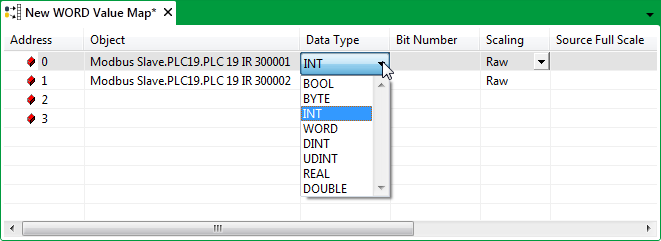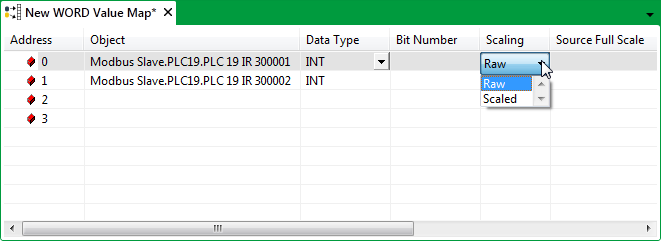These column headings are displayed for Value Maps other than BIT Value Maps:
- Address—The unique identifier for the entry within the Value Map. The address is allocated automatically when you Specify the Map Size.
- Object—The name of the item. This information is inherited from the variable, point, or other type of value when you associate it with the Value Map.
- Data Type—The format of the data for the item. The type is inherited from the variable, point, or other value when you associate it with the Value Map.
A Data Type combo box is displayed whenever you select a populated row, allowing you to select another compatible data type if required.

Select a Data Type that:
- Is suitable for the application for which it is being used
- Helps ensure that values are converted to a type that supports the data source’s range.
Some precision is lost whenever a larger data type is converted to a smaller data type (for instance, if a WORD value is converted to a BYTE value). Only use such a conversion if this will not result in invalid readings being passed to a Slave’s Master (for example, if a point never rises above a particular value).
If a REAL (floating point) value is converted to any other data type, you should enable scaling (see below) to ensure that any value after the decimal place is not lost.
A BOOL (Boolean) data type will read False if the value is 0 to 1/2 scale, and True if the value over 1/2 scale. As such, if the full range of a BOOL is 0 to 100, the data will read False when the value is below 50, and True when the value is above 50.
Example:
A Modbus analog floating-point value defaults to REAL when mapped to a WORD Value Map.
Due to limited resources at the Modbus Slave, the analog value has to be mapped to an Input Register Map and be reported to the Modbus Master as a Word rather than a REAL Value.
In order to fulfill these requirements, the floating-point value is converted from a REAL to a WORD Data Type, resulting in it taking up only one row of the WORD Value Map (rather than 2 rows for a REAL value).
The value is suitably scaled (see below) for transfer to the Modbus Master.
- Bit Number—Unused except where a row is converted into a multi-bit value block, in order to read individual bits within a value (see Enable Mapping of Individual Bits within a Multi-bit Value Map).
Where a multi-bit value block is used, specify which bit of a value is mapped to an individual entry in the Value Map. (A multi-bit value block is in effect a BIT Value Map embedded within another type of Value Map.)
- Scaling—Use to specify whether any scaling is required when data is transmitted between the source (the point, variable, or other value) and the Value Map (a memory block within the Slave).
Choose from:

- Raw—The value is transferred directly, with no scaling.
- Scaled—The value is scaled, using the Source and Target ranges specified in the adjacent fields. It is advisable to scale a value if its Data Type is being converted from REAL (IEEE floating-point value) to another data type. Use the settings in the next four columns to specify the scaling that is required when the value is transmitted to the Value Map.
- Source Full Scale—Used if the Scaling option is set to Scaled. This defaults to the full scale that has been specified for the point. Alter the scale if necessary.
- Source Zero Scale—Used if the Scaling option is set to Scaled. This defaults to the zero scale that has been specified for the point. Alter the scale if necessary.
- Target Full Scale—Used if the Scaling option is set to Scaled. Specify the value to which the variable, point, or other value’s full scale is to be scaled when it is read by the Value Map. An equivalent target scale is given by default, which can be altered if required. The default is the full range of the data type, or 100 for REAL types.
- Target Zero Scale—Used if the Scaling option is set to Scaled. Specify the value to which the variable, point, or other value’s zero scale is to be scaled when it is read by the Value Map. An equivalent target scale is given by default, which can be altered if required.
Example:
A floating-point analog value has been configured to have its Data Type converted from REAL to WORD when mapped to a Value Map. To avoid the analog value being truncated when read by the driver, the value is scaled on the Value Map. The default settings are used, whereby the point’s 0 to 100 scale is converted to 0 to 65535 at the Slave.
At the Slave’s master, the point value is reverse-scaled, whereby the 0 to 65535 scale is converted to a scale of 0 to 100.